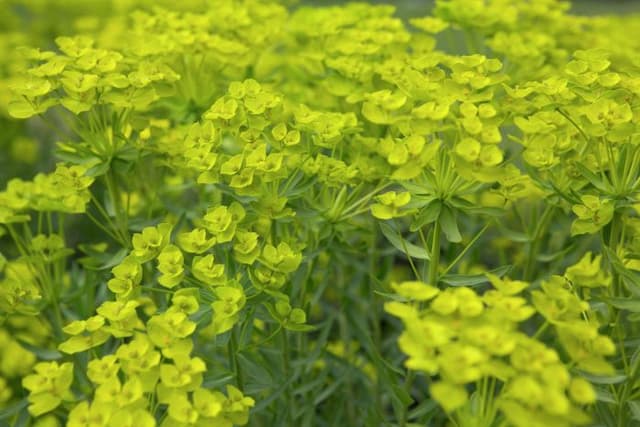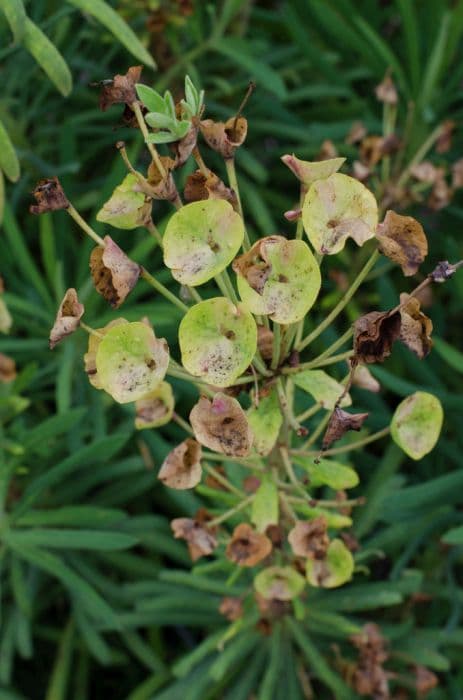Wood spurge 'Purpurea' Euphorbia amygdaloides 'Purpurea'

ABOUT
'Purpurea' is a softly downy evergreen perennial to 75cm tall, with deep purple stems and leaves, and contrasting lime-green flowers opening at the ends of the leafy stems in spring and early summer
About this plant
 Names
NamesSynonyms
Purple Wood Spurge, Red-Leafed Spurge, Purple Leaf Euphorbia.
Common names
Euphorbia amygdaloides 'Purpurea'.
 Characteristics
CharacteristicsLife cycle
Perennials
Foliage type
Evergreen
Color of leaves
Purple
Flower color
Yellow-green
Height
1-2 feet (0.3-0.6 meters)
Spread
1-2 feet (0.3-0.6 meters)
Plant type
Shrub
Hardiness zones
7
Native area
Europe
Benefits
 General Benefits
General Benefits- Attracts pollinators: This variety of Wood Spurge is known for its ability to attract beneficial insects like bees and butterflies due to its nectar-rich flowers.
- Drought tolerance: Once established, Euphorbia amygdaloides 'Purpurea' is quite drought-tolerant, making it suitable for xeriscaping or in gardens that receive little water.
- Low maintenance: It requires minimal care beyond the initial planting and occasional watering in very dry conditions, thus it's great for gardeners seeking low-maintenance plants.
- Year-round interest: With evergreen foliage and a display of purple leaves that intensify in color during the colder months, this plant provides visual interest throughout the year.
- Erosion control: The root system can help stabilize soil on slopes, assisting in the prevention of soil erosion.
- Deer resistance: Generally, it is not preferred by deer, which makes it a good choice in areas where deer browsing is a common issue for gardeners.
- Landscape versatility: It can be used in various garden settings, including borders, rock gardens, and as ground cover, thanks to its adaptable growth habit.
- Color contrast: The purplish foliage offers a striking contrast when planted among other green-leaved plants, enhancing the visual appeal of the garden landscape.
 Medical Properties
Medical PropertiesThis plant is not used for medical purposes.
 Air-purifying Qualities
Air-purifying QualitiesThis plant is not specifically known for air purifying qualities.
 Other Uses
Other Uses- Euphorbia amygdaloides 'Purpurea', commonly known as Wood Spurge, can be used as a natural dye, providing a range of earthy tones depending on the mordant used during the dyeing process.
- In garden design, the purplish foliage and greenish-yellow flowers can act as a beautiful contrasting element particularly in rock gardens and alpine settings.
- The plant's dense growth habit makes it an effective ground cover in shady areas where other plants might struggle to thrive.
- The milky sap of Wood Spurge has been historically used as a fish poison in small bodies of water, though this practice is environmentally harmful and generally not recommended or legal.
- Its striking foliage can be included in cut flower arrangements, but the sap should be handled carefully to avoid skin irritation.
- Wood Spurge can be a valuable addition to a butterfly garden, as it provides nectar for a variety of pollinating insects in the spring.
- The robust nature of Wood Spurge can be utilized in erosion control to stabilize soil in areas prone to erosion.
- Its evergreen leaves can provide winter interest in gardens that otherwise lack greenery during the cold season.
- Through companion planting, Wood Spurge can be paired with other plants that prefer similar conditions, helping to create a cohesive and aesthetically pleasing garden ecosystem.
- As a part of wildlife gardens, Wood Spurge can offer shelter and habitat to small ground-dwelling creatures like insects and amphibians.
Interesting Facts
 Feng Shui
Feng ShuiThe Wood Spurge is not used in Feng Shui practice.
 Zodiac Sign Compitability
Zodiac Sign CompitabilityThe Wood Spurge is not used in astrology practice.
 Plant Symbolism
Plant Symbolism- Endurance: Euphorbia amygdaloides 'Purpurea', commonly known as Wood Spurge, often symbolizes endurance due to its ability to thrive in various conditions and its resilient nature.
- Protection: In historical contexts and folklore, Wood Spurge was sometimes considered a plant of protection, believed to ward off evil spirits and negative energies.
- Healing: The genus Euphorbia is associated with medicinal properties, and as such, the Wood Spurge can represent healing, both physical and emotional.
 Water
WaterFor the Wood Spurge (Euphorbia amygdaloides 'Purpurea'), water deeply once a week during dry periods, allowing the soil to dry out slightly between waterings. Use about 1 gallon of water per square yard each week, adjusting for rainfall. Avoid overhead watering to minimize the risk of disease. During the winter, reduce watering as the plant's growth slows down.
 Light
LightWood Spurge prefers a spot with partial shade to full sun. It can tolerate a range of light conditions but thrives best with morning sun and afternoon shade, or dappled sunlight throughout the day. Avoid deep shade as it can lead to leggy growth and fewer leaves.
 Temperature
TemperatureWood Spurge is hardy and can withstand temperatures as low as 0°F and as high as 90°F, but its ideal temperature range is between 60°F and 75°F. It is a resilient plant that can survive seasonal fluctuations in temperature and is suitable for growth in USDA hardiness zones 5 through 9.
 Pruning
PruningPrune Wood Spurge in late winter or early spring to remove any dead or damaged stems and to maintain its shape. Pruning can stimulate new growth and enhance the plant's appearance. Prune sparingly as the plant typically maintains its form well without too much intervention.
 Cleaning
CleaningAs needed
 Soil
SoilWood Spurge (Euphorbia amygdaloides 'Purpurea') thrives best in well-draining soil mix with organic matter such as peat, perlite, and compost. A pH range between 6.0 to 7.5 is ideal for this plant to ensure nutrient availability.
 Repotting
RepottingWood Spurge typically requires repotting every 2-3 years or when it has outgrown its current container. It's important not to repot too frequently to avoid stress to the plant.
 Humidity & Misting
Humidity & MistingWood Spurge prefers moderate humidity levels but is quite adaptable and can tolerate the drier conditions found in most homes.
 Suitable locations
Suitable locationsIndoor
Place in bright, indirect light, avoid overwatering.
Outdoor
Plant in partial shade, shelter from strong winds.
Hardiness zone
5-9 USDA
 Life cycle
Life cycleEuphorbia amygdaloides 'Purpurea', commonly known as Purple Wood Spurge, starts its life cycle as a seed, which germinates in moist soil in spring. The seedling emerges and develops into a young plant with characteristic purple-tinged foliage and a robust root system. As it matures, the plant produces upright stems and leaves, entering a vegetative growth stage where it increases in size and strength. Typically, in the spring, Purple Wood Spurge enters its reproductive stage, flowering with small, greenish-yellow flowers surrounded by showy, dark purple bracts that attract pollinators. After pollination, the plant forms seed capsules that eventually burst, dispersing seeds for the next generation. In winter, the plant may die back, especially in colder climates, but the roots often survive to send up new growth the following spring, completing the life cycle.
 Propogation
PropogationPropogation time
Spring-Early Summer
Euphorbia amygdaloides 'Purpurea', commonly known as Wood Spurge, is typically propagated by taking cuttings. The most popular method is to take stem cuttings during late spring or early summer when the plant is actively growing. Select a healthy stem and cut a piece about 4 to 6 inches (10 to 15 cm) long, making sure there are several leaves present. Remove the lower leaves to expose a clear length of stem. It's important to allow the cut end to dry for a day to prevent the oozing sap from causing rot. Once the cut end is calloused, dip it in rooting hormone to encourage root growth and insert it into a pot filled with a mix of moist sand and peat to hold the cutting erect. Cover the pot with plastic to maintain humidity levels and place it in a warm location with indirect light until new growth indicates that rooting has occurred, which typically takes a few weeks.









